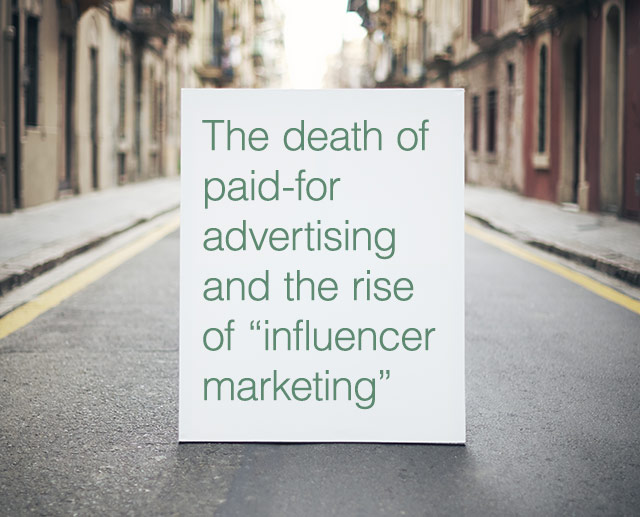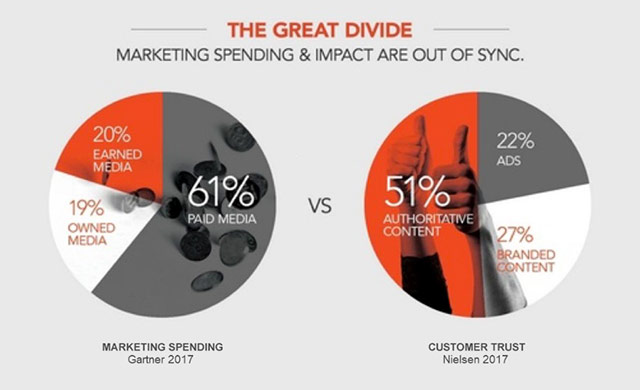
The death of paid-for advertising and the rise of “influencer marketing”
Recent research is showing something stark: a significant reduction in the power and effectiveness of “traditional” paid-for advertising. With the advent of social media and its emergence as the dominant communication medium, people can now quickly and easily see and read what peers, friends, celebrities, commentators, and key influencers have to say about a product, a movie, new music, a restaurant, holiday, travel options, a new company service a bank, an insurer…or whatever it might be. People trust the influencer more and their decision-making and choice is nowadays much more driven by that than by any piece of paid for advertising.

In the past 5 yrs, there have been a number of developments which have established “Influencer Marketing” over the value and efficacy of paid for advertising:
Some stats:
- 69% of consumers say that their preferred shopping channel is through social media and social networks
-Accenture survey - 74% cite peer recommendation as the key influence on their purchase decision
-IDC Research - 82% of people use recommendations from people they know to decide what to buy
-Nielsen - 58% of consumers say they are ready to share their experiences of a company or Brand
-Ogilvy /TNS report - Influencer Marketing now generates the highest RoI of all marketing activity with up to 6x return for every $ spent
-HYPR
Alongside all the positive developments around Social media and IM there have been other developments which are making display and paid for advertising less attractive:
- The number of people using ad blockers is now estimated at 200m meaning that about 20% of all the online advertising never even gets seen!
This trend has been encouraged by the likes of Apple who allow third-party developers to sell ad blocking apps on its AppStore. - The costs of online advertising for example have increased substantially over the past 5 yrs further reducing its RoI.
Advertising is now dominated by the duopoly of Google and Facebook who take c.65% of all online ad-spend (with Google having the majority of that). That duopoly have led a substantial increase in advertising costs, estimated to have risen 300% in the past 5 yrs, with eg Google cost /branded click costing up to 61% more in the past 12 months (research by SearchEngineLand). - Programmatic advertising which is intended to increase reach and frequency at cost-effective rates is often now resulting in sub-prime, less effective ad space which realistically few of the target audience will see.
In addition, this automated approach to advertising has resulted in some ads being put in the wrong place eg alongside improper or indecent content, forcing some Brands to withdraw from this type of advertising approach.
In the meantime, “IM” has reached critical mass and is beginning to outperform online display in driving sales and conversion.
Influencer marketing grew up organically starting with the birth of the key social media platforms in 2007/8. Then a few evangelists, unpaid and unprompted, starting blogging and then vlogging sharing their thoughts and opinions on anything and everything including the latest new product launches from well-known Brands.
Burberry was one of the first to recognise the growing influence and number of followers these people were having and began to formalise its approach, one of the first to post on Facebook, to utilise Twitter, and to adopt social media and promotion through influencers as its central marketing tenet. All the other luxury brands have to some extent or other now followed and they have set the pace and trends for all B2C brands to look at what social media and IM can do for them and to test and trial how effective it can be.
Let’s consider a couple of case studies:
Public Desire
Public Desire (www.publicdesire.com) is a successful online start-up operating in the footwear market, based originally in the UK with a primary customer base of 16 to 25yr old females, priding itself on competitive pricing and savvy use of social media and IM.
Even before its formal launch, it set up on Instagram to gauge customer reaction and to tweak its offer and product proposition.
“When we first started, Instagram and influencers were really taking off…we understood the potential there and I think customers nowadays are more loyal to influencers and more likely to respond to them, more so the real influencer who’s also a user as opposed to some celebrity who’s obviously being paid for their endorsement”
“Our Instagram account hit 1 million followers last year, we have 35k on Twitter and nearly 100k on Facebook and have a very impressive Snapchat following too.
“We feel you have to look at where your customers are and where they want to be and to understand how technology and how social media is changing. We want to be the first to market in everything we do. So far, in our sector, there’s no other footwear retailer online who is as focussed and successful on social media as we are.”
-co-founder Ateeq Akhlaq
LifeBEAM
Wearable technology company LifeBEAM wanted to launch a new AI-powered personal fitness product, Vi. They decided to form a brand advocacy group to raise attention for the Kickstarter campaign they were using to fund this project. Through the power of social media this became a great success.
More than 100 brand advocates signed-up to promote the brand with the promise of free product trials, discounted purchase price etc. They were also provided with product samples, demos and invitations to first to see/private events. These 100 became committed “disciples” and were instrumental in raising the $1.6m Kickstarter required.
As IM becomes a more developed marketing tool, so companies are realising they don’t need to sign-up the biggest celebrity they can. It’s much more about authenticity, that’s become the latest buzz. Finding people who are brand users and already keen advocates, they are the ones who have the credibility and believability that can properly influence others’ purchasing behaviour. Such people are now also being described as “micro-influencers”, perhaps with just a small influence network themselves but who allied with a multitude of similar others can form a powerful group.
Brands also are finding that micro-influencers are easier to find, quicker to sign-up and more controllable in what they say (as opposed to some celebrity figure who might be more inclined to say something unscripted!). Also such micro-influencers cost less. Most will charge c. £100 and often significantly less per branded post. On Facebook, the average micro-influencer charge is a usually a lot less than the average $250 per branded Facebook post.
All this means that for a campaign cost of c.$5k, a brand could expect eg approximately 35 to 100 Instagram posts that could reach c. 200k followers, or around 60 to 200 Twitter posts that could reach around 300k or around 35 to 100 Facebook posts that could reach around 125k followers, or some combination thereof.
So not a substantial investment, the ability to easily trial and set-up, if unsure outsource to one of the myriad of agencies who now offer social media IM platforms and campaigns, easy to track and measure, and discovering and unleashing the potential of that wider group of people who love your product, want to tell people about it and happy to take a small fee to do that.
To sum up here are some more good examples of IM:
Glossier
Glossier (www.glossier.com) is a US-based start-up selling beauty and skin care products. It’s been rated as “Most Innovative Company” and owes much of its early success and cult following to ever-expanding network of micro-influencers.
Instead of paying a few big names, Glossier relies on “regular people” to spread the word. “What’s very motivating is this idea of every single woman can become an influencer with us…we now have a referral program to enable more influential followers to join us and to offer product discounts and other incentives to their own networks”
Unilever
Unilever has been doing something similar with its Dove brand of skin care, trying to encourage its target user base to blog and comment on its products.
“We want to focus on empowering content. Every year consumers get more savvy and critical and they ask more of brands. So for example we have developed our Dove Self Esteem Project. That has generated a wealth of testimonials, compelling stories and ideas. It also now includes plans to go into 165 schools this year to lead lessons, activities and provide resources. The whole Self Esteem programme has reached 1.5 million people in the UK…it’s a conversation the brand is committed to having with women, but we’re also committed to it longer term and with the upcoming generation.”
-Alison Fisher, Unilever Marketing Manager
Hallmark
Hallmark, the greeting card provider, decided they needed to engage much more effectively with their audience and find ways to encourage visits to their web site and use of their personalised greeting cards.
They decided to build an online community of families who had a large number of followers and who enjoyed posting and sharing photos online…they had many to select from!
They invited them to join a program which would run on Instagram to share personal moments from their family’s holiday. They were encouraged to offer “candid glimpses” into their own family holiday traditions.
In return for posting these photos, they were encouraged to share them with their own network and followers and add links to Hallmark’s personalised greeting cards. There were prizes for best photos and also families were given free use of Hallmark’s personalised service and discounts on other merchandise.
While simple to set up and implement, this IM campaign proved very popular and successful and was voted in the annual Shorty Awards as one of the best IM initiatives.
The target audience spent more than 25 million minutes engaging with campaign content. Hallmark achieved a high share of voice in all the key social media where people were posting and sharing holiday photos. Most importantly for the first time for Hallmark it built at very low cost an influencer base and set of relationships which could be leveraged for future activity.
One of the most thorough studies on the ROI of using Influencers was done by Nielsen Catalina Solutions. They followed the marketing efforts of a Fortune 500 consumer goods company. Here are the results:
- Influencer marketing yields an annual ROI of $23, compared to the $4.30 on the brand’s best performing banner ads
- For every 1000 views, influencing brought in $285 in incremental sales
- Influencer campaigns brought in 11 times the ROI of traditional advertising over the course of a year
“No wonder that 84% of Marketers in a recent survey said they planned at least one IM campaign this year.”
-Marketing Insider Group
Article also available for download as a PDF
Related Articles
- Finding talent just got easier
- A new 2025 business model
- Quiet Quitting: 7 rules for managing it
- Building Out the Digital Team
- Digital and Data Transformation: 10 keys to success
- Leading B2B companies using digital to power sales & profit growth
- Employee engagement is the key to digital change and transformation
- What is the HR impact of digital on future talent needs and hiring?
- Evolution of the CDO role: 3 options for success
- Digital evolution of Marketing
- Winning in the talent wars
- Untapped potential of effective Customer Data & Analytics
© Michael de Kare-Silver 2023
Michael runs this specialist recruiting /headhunting practice Digital Prospects, helping companies recruit key talent where Digital and /or Data skills and savvy are important.
Michael used to be MD at Argos.co.uk and of Experian.com, he is ex McKinsey strategy consulting and Procter & Gamble marketing, Michael provides a personal and dedicated recruitment service that delivers results and is built on treating people with kindness and respect.